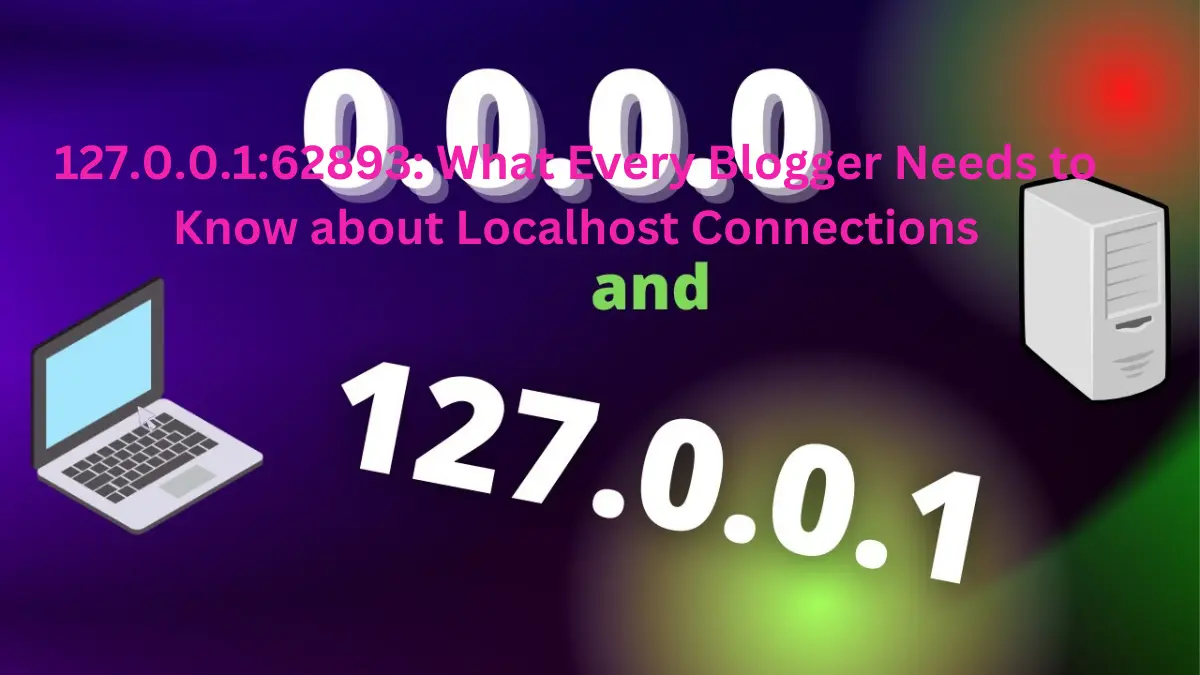127.0.0.1:62893: What Every Blogger Needs to Know about Localhost Connections

Imagine working on your blog offline, making changes, testing new features, and experimenting with designs without affecting your live site. Sounds like a dream for every blogger, right? Well, that’s where localhost connections come into play! In this blog post, we’ll dive into the world of localhost and uncover everything you need to know to supercharge your blogging experience. So please grab a cup of coffee and explore the power of 127.0.0.1:62893!
Understanding Localhost Connections
Localhost connections refer to hosting a website on your computer instead of relying on a live server. When you access localhost, your browser is directed to 127.0.0.1:62893! which points back to your device. This allows you to work on your blog in a secure and isolated environment without affecting the public-facing site.
Understanding how localhost works is crucial for bloggers who want to test new themes, plugins, or code changes before deploying them live. Setting up a local host environment allows you to experiment freely and troubleshoot issues without risk.
Localhost acts as a sandbox where you can play with different blog elements without worrying about breaking anything online. It’s like having a virtual playground for all your blogging experiments right at your fingertips!
Read More: 127.0.0.1:62893: A deep dive into localhost connections
The Importance of Localhost for Blogging
Have you ever encountered the frustration of making changes to your blog only to discover they need to look more right once published? This is where localhost comes to the rescue for bloggers. Localhost allows you to test and tweak your website locally before going live by simulating a live server environment on your computer.
Localhost provides a safe space for experimentation without impacting your actual site. Whether customizing themes, adding new plugins, or debugging code, localhost enables you to see immediate results without affecting the user experience on your live blog.
In addition to its practicality, localhost can enhance productivity by streamlining the development process. You can work on your blog offline anytime and make changes without an internet connection. Plus, with faster loading times compared to remote servers, localhost offers a seamless editing experience for bloggers aiming for efficiency in their workflow.
Embracing the power of localhost empowers bloggers with greater control over their websites’ design and functionality. It’s not just about convenience; it’s about ensuring that every aspect of your blog reflects precisely what you envision before sharing it with the world.
Setting Up a Localhost Environment
Setting up a local environment is crucial for bloggers who want to test their websites locally before going live. By running a server on your computer, you can make changes and see how they impact your site without affecting the live version.
To begin, you’ll need software like XAMPP or WAMP that includes Apache, MySQL, and PHP to create a local server environment. Installing these applications is simple and usually involves just a few clicks.
Next, configure your localhost settings by creating a database for your blog and setting up the necessary permissions. This step ensures that your website functions correctly in the local environment.
After setting up the basics, it’s time to upload your log files to the appropriate directory in your localhost server. Ensure all paths are correct to ensure all links and assets on your site are intact.
Test everything thoroughly by accessing your blog through localhost using a web browser. Check functionality, design elements, and overall performance to ensure everything works as expected before publishing online.
Common Issues with Localhost Connections
Bloggers may need help with their workflow when working with local-host connections. One prevalent problem is configuration errors, where incorrect settings prevent the local server from running smoothly. Troubleshooting these issues often requires a keen eye for detail and a good understanding of server setups.
Another issue bloggers need help with is port conflicts, especially when running multiple projects simultaneously. This can lead to confusion and difficulties in accessing the correct local environment. Resolving port conflicts involves identifying conflicting applications or services and assigning unique ports to each project.
Furthermore, firewall restrictions or antivirus software sometimes block localhost connections, causing frustration for bloggers trying to test their websites locally. Adjusting security settings to allow proper communication between the local server and the browser is essential.
Awareness of these common issues and how to troubleshoot them effectively is crucial for maintaining a seamless localhost connection while blogging.
Tips for Optimizing Your Localhost Setup
Optimizing your Localhost setup is crucial for a seamless blogging experience. To start, make sure to choose the right software or tool that suits your needs. Whether it’s XAMPP, MAMP, or another option, select one that aligns with your technical skills and requirements.
Next, keep your Localhost environment tidy by organizing files into separate folders based on projects. This will help you stay organized and improve the speed of accessing and editing files. Regularly cleaning up unnecessary files and databases can prevent overload and enhance performance.
Another tip is to utilize caching plugins or tools to boost loading speeds when working on your blog locally. By enabling caching mechanisms, you can simulate real-world website conditions and ensure everything runs smoothly before going live. Staying updated with the latest software and plugins is essential for security and performance enhancements.
Implementing these optimization tips into your Localhost setup routine can elevate your blogging efficiency while avoiding common technical hiccups.
The Future of Localhost in Blogging
The future of local hosts in blogging is undoubtedly promising. As technology advances, bloggers will continue to rely on local environments for efficient testing and development. With the rise of mobile-first indexing and progressive web apps, having a reliable local host setup will ensure optimal performance across various devices.
Moreover, as SEO algorithms evolve, bloggers must test their websites locally before deploying changes live. This practice saves time and minimizes the risk of unexpected issues affecting user experience. Hosting platforms may also integrate more features specifically tailored to optimize local connections, making it easier for bloggers to simulate real-world scenarios during development.
Incorporating automation tools and AI-driven solutions into localhost environments could streamline code deployment and testing tasks. This could revolutionize how bloggers manage their websites locally, enabling them to focus more on creating quality content rather than constantly troubleshooting technical issues.
Conclusion and Next Steps for Bloggers
Understanding and utilizing localhost connections can significantly enhance your workflow and productivity as a blogger. From setting up a local environment to troubleshooting common issues, optimizing your localhost setup is crucial for seamless content creation.
Looking ahead, the future of localhost in blogging looks promising as more tools and resources continue to emerge, catering to the needs of content creators. By staying informed and adapting to new developments in this space, bloggers can stay ahead of the curve and maximize their potential.
Embracing local-host connections can empower you to create high-quality content efficiently while ensuring a smooth blogging experience. Take the time to properly set up your local host environment, address any challenges, and explore ways to optimize your setup for optimal performance. By doing so, you’ll be well-equipped to tackle any blogging project with confidence and ease.





